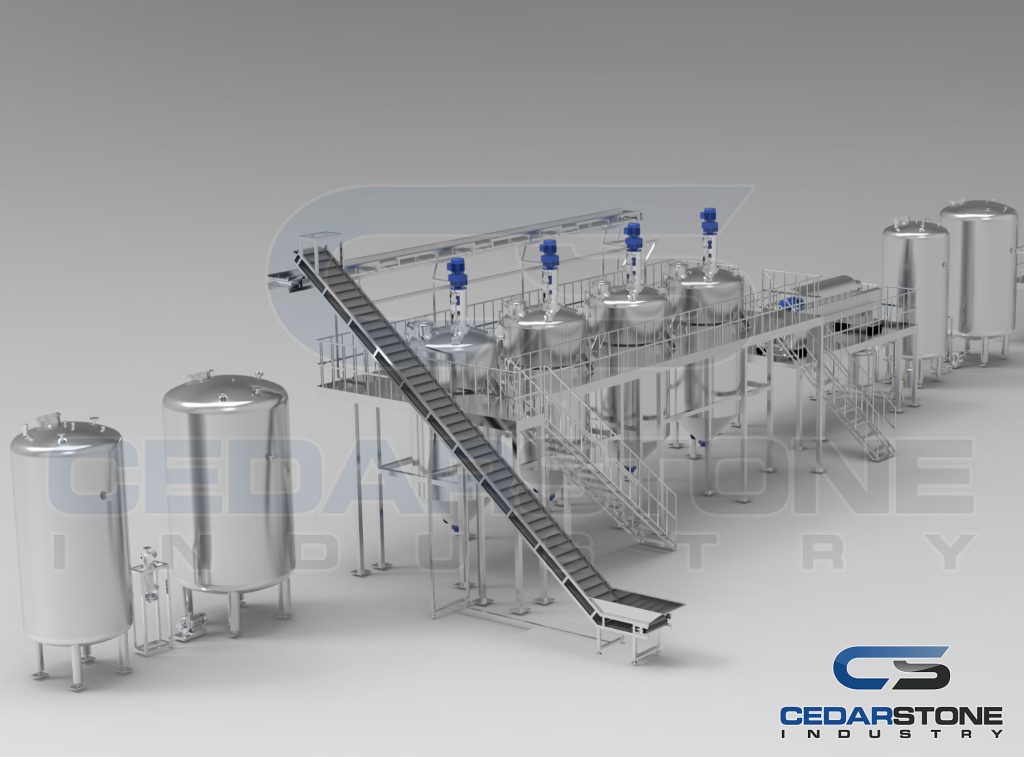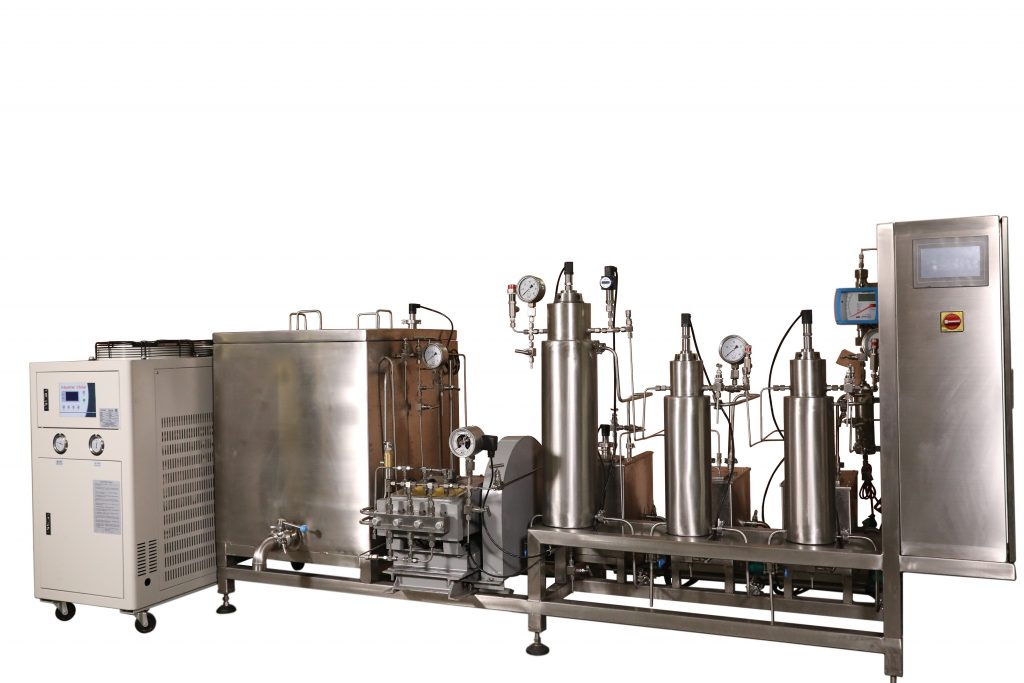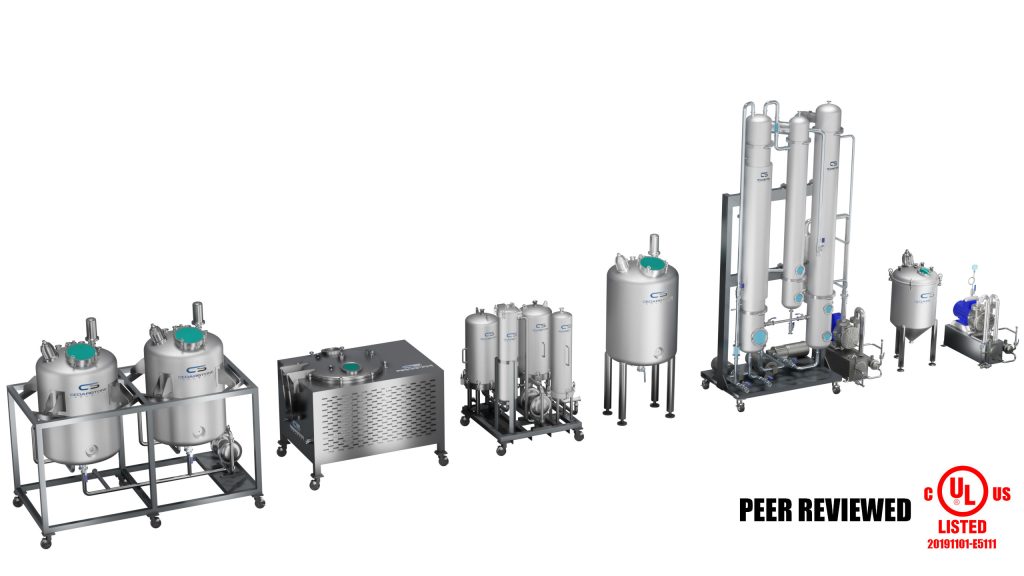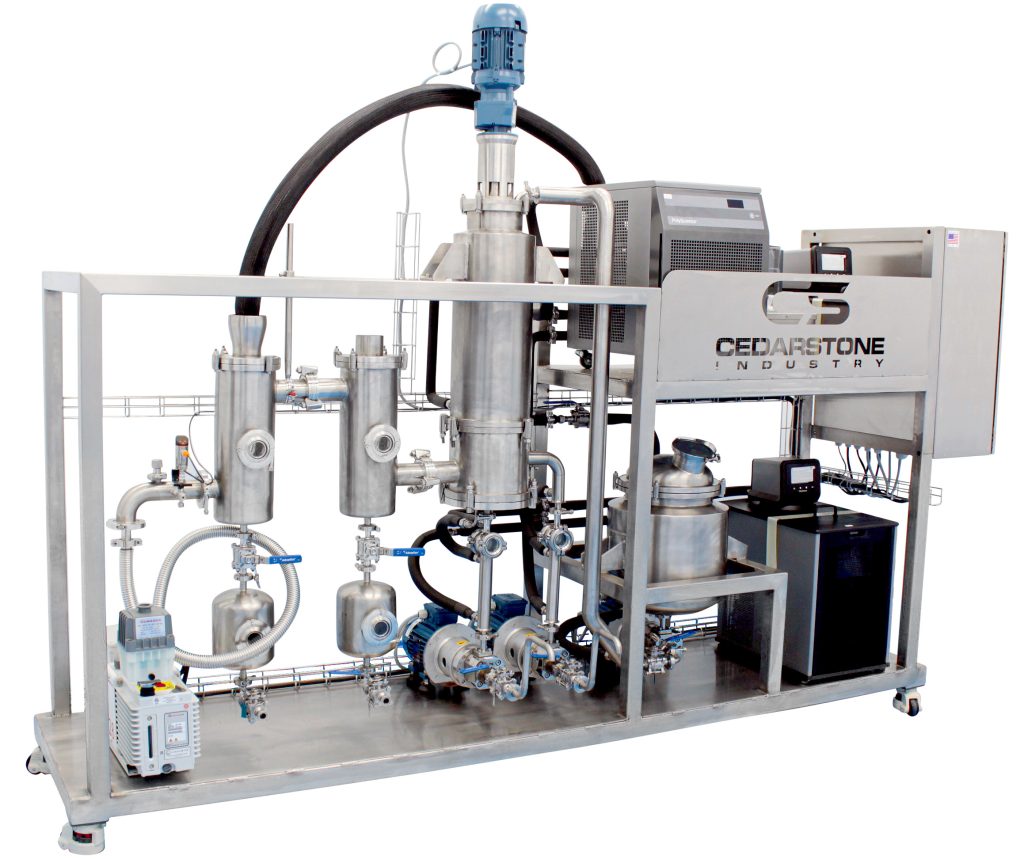When it comes to subcritical CO2 extraction equipment, you need a manufacturer that knows what they’re doing. Cedarstone Industry provides the best environmentally-friendly extraction systems for your essential oils. To get the most out of plant material, you need the right temperature and pressure for your extraction process. Our team of experts is here to help you find the right tools for your processing, so contact us today for a quote.
Whether it’s cannabinoids or terpenes, you need the right extraction solvents and solvency power for the job. Fortunately, our supercritical CO2 extraction equipment gets the job done at exceptional extraction times. From subcritical to supercritical systems, Cedarstone Industry has a full spectrum of tools for your extraction methods. We take into account everything from high temperatures to cost-effectiveness. When it comes to supercritical carbon dioxide, one wrong move can ruin the entire product and set you back significantly.
Our offices are available Monday through Friday from 7:00 AM to 4:00 PM. Whatever day works best for you, make sure to take advantage and get in touch with us as soon as possible. Let experts in oil extraction and supercritical fluid extraction guide you with the right equipment. So don’t wait and get the right subcritical CO2 extraction equipment for your business today.

Industrial Scale Extraction System
Supercritical Fluid Extraction Vs Ethanol Extraction
This is the million dollar question because there are many factors which can limit your solvent options. The short answer is ethanol, for reasons we discuss shortly but the justification for this answer is a compromise between three key factors: selectivity, cost, and safety. Safety also happens to be the X-factor by virtue of the exponential effect it can have on cost.
Solvent selectivity
Molecules and solvents can be classified by their polarity: polar vs nonpolar (or somewhere in between). CBD is very nonpolar. Water is very polar. Adhering to the very old and very true adage, “like dissolves like”, we can correctly assume that water is ineffective for CBD extraction. While you may have heard of water (or “bubble”) hash, this is actually a physical separation of the trichomes from the rest of the plant. The potency of this extract peaks at around 45% CBD and is unsuitable for crystallization whereas solvent extracts reach 90% CBD and can be further processed to reach 99% after crystallization. For this reason, we will omit water hash from the discussion of high-throughput hemp processing.
Clearly, nonpolar solvents are chemically ideal for CBD extraction so does that mean ethanol is a nonpolar solvent? No. Ethanol is considered “somewhere in between” on the scale of nonpolar vs polar. Thus, it has the disadvantage of extracting polar molecules such as pigments, sugars, and- you guessed it- water. If ethanol is so much less selective than a common industrial nonpolar solvent such as butane or hexane, why would we use it? You guessed it- cost and safety.
Before we weigh the pros and cons of solvent safety, another common nonpolar extraction solvent deserves honorable mention- carbon dioxide.
When carbon dioxide is under enough pressure and temperature, it transitions to a fourth state of matter- a supercritical fluid. Extraction using carbon dioxide is called SFE (supercritical fluid extraction). In SFE, carbon dioxide is purchased very inexpensively in its liquid state and the pump on the CO2 machine brings it up to supercritical pressure while heaters bring it up to supercritical temperature. The pump must be very robust to achieve these pressures as well as the vessels and tubing in order to withstand these conditions safely. The end result is a SFE machine that is cost prohibitive for most start-ups. A “high capacity” SFE machine starts at $500,000 and can only extract approximately 25 pounds per hour whereas a similar throughput ethanol extraction unit costs about 10X less. That being said, carbon dioxide is the safest of the relevant extraction solvents being used in the industry today. But, you may ask, isn’t safety the X-factor? The answer is yes, but SFE has a major caveat: carbon dioxide also extracts lipids (AKA waxes and fats). Removal of lipids requires the painstaking and costly step of precipitation or “winterization”. Not only is this process inefficient but it negates the safety advantage of CO2 by requiring the use of ethanol. Is ethanol unsafe? No, it is again “somewhere in between”. Ethanol is more dangerous than carbon dioxide (after all, carbon dioxide is a fire extinguisher) but less dangerous than hydrocarbon solvents (i.e., hexane or butane).
Safety
For the sake of argument, let’s pretend that your hemp processing start-up company has the technical and engineering expertise to build a safe, reliable extraction facility with the equipment, infrastructure, and safeguards necessary to prevent a catastrophic accident involving the volatile solvent hexane or the gaseous butane or propane. Is your Fire Marshal willing to send his or her men and women into an explosive situation just so you can beta-test your cannabis facility in your proof-of-concept business venture? If you are a first-mover in that Fire Marshal’s jurisdiction, the answer is probably no. If entrepreneurs have already tried this and the result was a fire or explosion, the answer is a resounding NO. Per the NFPA codes, closed-loop light hydrocarbon extraction using butane or propane requires C1D1 construction which is very stringent and very high cost.
Let’s take this hypothetical situation one step further and assume that your Fire Marshal does in fact allow hydrocarbon extraction. Let’s also assume you aren’t using butane or propane due to the limitation in throughput inherent in pressurized batch extraction. That leaves us with pentane, hexane, or heptane- all of which behave almost identically with the exception of boiling point (this detail is inconsequential in regards to extraction but has significant implications in the crystallization process, more on that later). With the multitude of ethanol extraction and evaporation equipment on the market today, one might be tempted to reappropriate said equipment for use with, say, hexane. While this in theory may seem perfectly reasonable, the devil is in the details. There are many fittings and seals in this equipment and some of them aren’t trivial (ie, a centrifugal seal or evaporation plate exchanger). The manufacturer designs and sells this equipment for use with ethanol and therefore the seals are designed to be chemically compatible with ethanol, not hydrocarbons. Case in point- use of 190 proof ethanol denatured with heptane will void the warranty of most centrifuge extractors because even 5% hydrocarbon by volume will destroy the seals.
By now, we have made a case for ethanol based on selectivity and safety but it is a scant case at that. If we reduce the solvent temperature to below zero degrees Celsius, however, selectivity and safety become significantly better.
Here’s why cryo-ethanol improves selectivity and safety:
Temperature affects the rate at which processes occur
Cold ethanol does not have a higher affinity for CBD nor a lower affinity for pigments and lipids. Lower temperature slows down the rate at which molecules move from the solid material (hemp) into the liquid material (ethanol). This rate is called the mass transfer coefficient. CBD, pigments, and lipids all have their respective mass transfer coefficients at a given temperature. The great thing about CBD is that its mass transfer coefficient is still quite high at very low temperatures. This is not the case for lipids and pigments such as chlorophyll. So by manipulating the temperature and halting the extraction until just after the bulk of the CBD has entered the solvent, we can improve de facto selectivity.
Just as low temperature slows down the rate of mass transfer, low temperature slows the rate of evaporation. As you probably know, it is not the liquid itself that is flammable but rather the vapor and its access to oxygen in the atmosphere for combustion. Thus, cryo-ethanol is much less flammable and likewise much less explosive than at room temperature. In fact, at -40 C there are so few ethanol molecules evaporating from the liquid surface, if a match were struck just above the surface (not recommended), it would not ignite. Since there is no reason to have ethanol in open use, a closed-loop system allows for safe and efficient transfer of solvent in the extraction and evaporation room. The NFPA code for closed-loop ethanol extraction calls for C1D2 (as opposed to C1D1 for butane) which significantly brings down costs and complexity.
Finally, ethanol is safer not just in terms of fire hazard but also in terms of consumer safety. Ethanol is classified by the FDA as a Class 3 solvent with low toxicity. It can be present at concentrations up to 5000ppm and still be considered safe for consumption. Moreover, ethanol can be certified as food grade, Kosher, and Halal.
Cost
Ethanol may be one of the more expensive solvents to choose from but its high cost can be managed in some ways and mitigated in other ways. The largest savings can be accomplished through ethanol recovery in the evaporation process. This is essentially ethanol distillation and has become standard procedure in the cannabis industry. A major disadvantage of ethanol distillation is the formation of an ethanol-water azeotrope which prevents the recovery of pure 200 proof ethanol. Regardless of the source of the water- in the plant, in the air, or condensation in cold vessels- the azeotrope is extremely difficult to break, resulting in recovered ethanol less than 185 proof. As more water comprises the ethanol, the solvation strength for CBD decreases. This is another often overlooked detail which can have a drastic effect on the cost of consumables. There are solutions for reproofing ethanol, such as molecular sieves and reproofing stills. The best solution, however, may be the choice of evaporation equipment which could avoid the problem altogether (see Evaporation Equipment section).
The next best way to maximize your ethanol savings is by using the same volume of ethanol multiple times for extraction. The reason behind this is simple- at a typical 1:1
hemp(lb):ethanol(gal) extraction ratio, the solvation capacity of ethanol far exceeds what will be extracted in the first batch of biomass. The number of batches which can be extracted by the same volume of ethanol depends on the CBD potency of the biomass, of course, but typically 7% biomass can be extracted at least three times before the ethanol nears saturation and solvation strength diminishes. Note: extraction of pigments and waxes also diminish solvation strength so cryo temperatures must be maintained in order to reuse the ethanol several times.
Another way to cut ethanol costs are through purchasing 190 proof denatured ethanol. Denatured ethanol does not incur the federal excise tax so the cost is significantly cheaper than 200 proof. It is important, however, to use ethanol denatured by n-heptane which is a food grade denaturant but be aware that the EPDM seals most likely in your extraction and evaporation equipment are not compatible with heptane. Another option is to purchase non-denatured 190 proof ethanol (w/ 5% water) but the small savings compared to 200 proof does not justify the dilution.
The final cost factor that makes ethanol extraction the best choice is the price of equipment. Being non-volatile, ethanol extraction equipment is designed to operate at atmospheric pressure, allowing for much more affordable materials, closures, valves, and safety measures. Furthermore, the highly competitive market of ethanol equipment drives the prices down.
Subcritical CO2 Extraction Equipment at the Right Price
Cedarstone Industry provides the highest quality processing and extraction machines in the business. Our company has been serving the country for over twenty years and continues to uphold the values from when we first began. From brewing to cannabis extraction, Cedarstone Industry has you covered on all fronts. We do everything we can to ensure you get solutions for your engineering, construction, and architectural needs.
Cedarstone Industry offers everything from extraction equipment to brewing equipment, pressure vessels, mixing vessels, stainless steel tanks, and more. We have also worked with companies such as Coca-Cola, Heineken, Bluebell, Tetra Pak, GE Pharmaceutic, GEA, Anheuser-Busch, and many others. Our mission is to provide the most reliable processing equipment for clients across the world. Whether it’s for beer or food, it’s essential to have the right tools at your disposal.
Our equipment is certified by The American Society of Mechanical Engineers (ASME), National Board of Boiler & Pressure Vessel Inspectors (NBBI), and 3A 63-03 Sanitary Standards. With our operations based in Houston, TX, we focus our efforts on companies all over the world. So no matter where you are, rest easy knowing that you get the best equipment with us.
Subcritical versus Supercritical CO2 Extraction
When it comes to products such as beer, wine, cannabis, and certain foods, the temperature and pressure are the keys to proper results. That is why it is essential to ensure that you have the right degree of these elements for the correct outcome. No matter what the material is, the right conditions must be met for the most exceptional results. To ensure that you get those results, we offer equipment perfect for both supercritical and subcritical CO2 extraction.
Supercritical CO2 Extraction
An essential factor in supercritical CO2 extraction is high temperature and pressure. This creates a substance known as a supercritical fluid. In application to cannabis, this liquid becomes a solvent that dissolves the membrane of raw cannabis material. This captures the active compounds in cannabis, and the solvent passes through one more pressurized separation vessel.
With fluctuating pressure and temperature, cannabinoids and terpenes are broken away. After that, the rest of the CO2 is put into a condenser to be stabilized back into a gas. This method takes less time than subcritical extractions and produces more. However, some terpenes are too sensitive for this process and lose their compounds.
Subcritical CO2 Extraction
Subcritical extraction goes through the same process but needs lower temperature and pressure. This method takes longer and produces less, but is perfect for more fragile material. Materials like terpenes, essential oils, and other chemicals. While supercritical extractions result in substances similar to peanut butter, subcritical extractions are more like molasses. While one retains larger molecules like omega 3 and 6 lipids, the other preserves additional cannabinoids aside from CBD.
With subcritical extractions, you hold onto the plant’s sensitive chemicals, which are valuable for full-spectrum cannabis products. While there is no clear answer on which method is better, it is entirely up to the circumstances. For instance, for faster products, supercritical CO2 extraction is the way to go. However, retaining the sensitive chemicals within the plant is essential for other reasons. Therefore, the decision is dependent on the desired goal.
Other Products We Provide
While understanding supercritical and subcritical CO2 extraction is significant, we also offer quite a few more options for your extraction. Whether you need to extract from cannabis, oil, or other materials, make sure that you have the right tools for the job. With Cedarstone Industry, you’re sure to get the best results the first time.
Centrifuge Extractor
Our centrifuge extractors are perfect for low-temperature ethanol and hemp extraction. Easy to operate and maintain, we design these extraction machines to be durable and user-friendly. These machines come with a variety of advantages that make cannabis and oil extraction a piece of cake. For instance, the centrifuge gives the user a safe and high-speed operation without sacrificing time or yield.
Molecular Distillation
Cedarstone Industry provides a liquid-liquid separation technology that breaks compounds down on a molecular level. Molecular distillation is widely considered the safest way to separate molecules and related compounds. Traditional distillation uses the boiling point difference separation principle, while the molecular distillation works on the molecular level.
The process is done with the Wiped Film Evaporator (WFE) System. This system uses extreme heating to dilute the compounds out of the material, while the remaining residue is left behind. This process has many applications, such as oil deodorization and purification after extraction.
Contact Us Today
Cedarstone Industry is dedicated to a better way to extract necessary materials. We provide the most reliable equipment for an unbeatable price. Call (281) 397-3700 or find us online for more information. Don’t hesitate and get your business the best supercritical or subcritical CO2 extraction equipment today.



